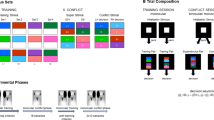Abstract
Four pigeons were tested, using an operant conditioning method with successive stimulus presentation, on a pattern discrimination task to determine whether or not they could distinguish patterns that were illuminated by near-ultraviolet (UV) light. Tests at red, green, and UV wavelengths showed that they could significantly discriminate not only the chromatic stimuli that were visible to human observers but also the UV-illuminated patterns that humans could not see. In control sessions, the birds’ performance deteriorated to chance levels when these UV wavelengths were blocked by additional filters. Their discrimination of UV patterns precludes that the pigeon’s known sensitivity to UV is mediated by a preretinal fluorescence, as is probably the case in some other animals, since such a fluorescence does not permit a focused retinal image. Possible retinal mechanisms mediating their UV detection are discussed.
Article PDF
Similar content being viewed by others
Explore related subjects
Discover the latest articles and news from researchers in related subjects, suggested using machine learning.Avoid common mistakes on your manuscript.
Reference Note
Kirschfeld, K. Personal communication, October 1982.
References
Bowmaker, J. K. The visual pigments, oil droplets and spectral sensitivity of the pigeon.Vision Research, 1977,17, 1129–1138.
Bowmaker, J. K., &Dartnall, H. J. A. Visual pigments of rods and cones in a human retina.Journal of Physiology (London), 1980,298, 501–511.
Brolin, S. E., &Cederlund, C. The fluorescence of the lens of the eyes of different species.Acta Ophthalmologica, 1958,36, 324–328.
Delius, J. D., &Nowak, B. Visual symmetry recognition by pigeons.Psychological Research, 1982,44, 199–212.
Dietz, M. Edrkroten konnen UV-Licht sehen.Naturwissenschaften, 1972,59, 316.
Donovan, W. J. Structure and function of the pigeon visual system.Physiological Psychology, 1978,6, 403–437.
Emmerton, J., &Delius, J. D. Wavelength discrimination in the “visible” and ultraviolet spectrum by pigeons.Journal of Comparative Physiology, 1980,141, 47–52.
Emmerton, J., Schwemer, J., Moth, I., &Schlecht, P. Spectral transmission of the ocular media of the pigeon (Columba livia).Investigative Ophthalmology & Visual Science, 1980,19, 1382–1387.
Emmerton, J., &Rsmy, M. The pigeon’s sensitivity to ultraviolet and “visible” light.Experientia, 1983,39, 1161–1163.
Gellermann, L. W. Chance orders of alternating stimuli in visual discrimination experiments.Journal of Genetic Psychology, 1933,42, 206–208.
Goldsmith, T. H. Hummingbirds see near ultraviolet light.Science, 1980,207, 786–788.
Govardovskii, V. I., &Zueva, L. V. Visual pigments of chicken and pigeon.Vision Research, 1977,17, 537–543.
Graf, V., &Noreen, D. V. A blue sensitive mechanism in the pigeon retina: λmax 400 nm.Vision Research, 1974,14, 1203–1209.
Hardie, R. C., &Kirschfeld, K. Ultraviolet sensitivity of fly photoreceptors R7 and R8: Evidence for a sensitising function.Biophysics of Structure and Mechanisra, 1983,9, 171–180.
Huth, H. -H., &Burkhardt, D. Der spektrale Sehbereich eines Violettohr-Kolibris.Naturwissenschaften, 1972,59, 650.
Kimeldorf, D. J., &Fontanini, D. F. Avoidance of ncarultraviolet radiation exposures by an amphibious vertebrate.Environmental Physiology and Biochemistry, 1974,4, 40–44.
Kreithen, M. L., &Eisner, T. Ultraviolet light detection by the homing pigeon.Nature, 1978,272, 347–348.
La Touche, Y. D., &Kimeldorf, D. J. Spectral sensitivity of the newt, Taricha granulosa, to visible and u.v. radiation.Coraparative Biochemistry and Physiology, 1979,63A, 313–317.
Merker, E. Die Sichtbarkeit ultravioletten Lichtes.Biological Review, 1934,9, 49–78.
Muntz, W. R. A. Inert absorbing and reflecting pigments. In H. J. A. Dartnall (Ed.),Handbook of sensory physiology (Vol. VII/l). Berlin, Heidelberg, New York: Springer-Verlag, 1972.
Norren, D. V. Two short wavelength sensitive cone systems in pigeon, chicken and dew.Vision Research, 1975,15, 1165–1166.
Said, F. S., &Weale, R. A. The variation with age of the spectral transmissivity of the living human crystalline lens.Gerontologica, 1959,3, 213–223.
Tan, K. E. W. P. Vision in the ultraviolet. Doctoral thesis, Rijksuniversiteit te Utrecht, 1971.
Wald, G. Human vision and the spectrum.Science, 1945,101, 653–658.
Wald, G.The Selig Hecht commemorative lecture (National Physical Laboratory Symposium No. 8). London: Her Majesty’s Stationery Office, 1958.
Woleaesht, M. L. The function of intraocular color filters.Federation Proceedings, 1976,35, 44–50.
Wright, A. A. The infiuence of ultraviolet radiation on the pigeon’s color discrimination.Journal of the Experimental Analysis of Behavior, 1972,17, 325–337.
Yoshizawa, T. The behaviour of visual pigments at low temperatures. In H. J. A. Dartnall (Ed.),Handbook of sensory physiology (Vol. VII/l). Berlin, Heidelberg, New York: Springer-Verlag, 1972.
Zipse, W. Konnen unsere heimische Frbsche und echte Kroten ultraviolettes Licht sehen?Zoologisches Jahresbuch, Abteilung Physiologic, 1935,55, 487–524.
Author information
Authors and Affiliations
Additional information
The work was supported by the Deutsche Forschungsgemeinschaft through its Sonderforschungsbereich 114.
Rights and permissions
About this article
Cite this article
Emmerton, J. Pattern discrimination in the near-ultraviolet by pigeons. Perception & Psychophysics 34, 555–559 (1983). https://doi.org/10.3758/BF03205910
Received:
Accepted:
Issue Date:
DOI: https://doi.org/10.3758/BF03205910




